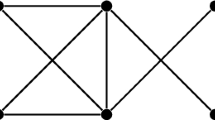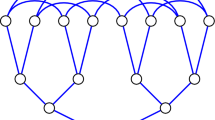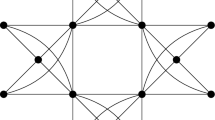Abstract
If we let \(n(k, d)\) denote the order of the largest undirected graphs of maximum degree \(k\) and diameter \(d\), and let \(M(k,d)\) denote the corresponding Moore bound, then \(n(k,d) \leq M(k,d)\), for all \(k \geq 3\), \(d \geq 2 \). While the inequality has been proved strict for all but very few pairs \(k\) and \(d\), the exact relation between the values \(n(k,d)\) and \(M(k,d)\) is unknown, and the uncertainty of the situation is captured by an open question of Bermond and Bollobás who asked whether it is true that for any positive integer \(c>0\) there exist a pair \(k\) and \(d\), such that \(n(k, d)\leq M(k,d)-c\).
We present a connection of this question to the value \(2\sqrt{k-1}\), which is also essential in the definition of the Ramanujan graphs defined as \(k\)-regular graphs whose second largest eigenvalue (in modulus) does not exceed \(2 \sqrt{k-1}\). We further reinforce this surprising connection by showing that if the answer to the question of Bermond and Bollobás were negative and there existed a \(c > 0\) such that \(n(k,d) \geq M(k,d) - c \), for all \(k \geq 3\), \(d \geq 2 \), then, for any fixed \(k\) and all sufficiently large even \(d\)’s, the largest undirected graphs of degree \(k\) and diameter \(d\) would have to be Ramanujan graphs. This would imply a positive answer to the open question whether infinitely many non-bipartite \(k\)-regular Ramanujan graphs exist for any degree \(k\).
Similar content being viewed by others
References
Alon, N.: Eigenvalues and expanders. Combinatorica 6, 83–96 (1986)
Bermond, J.-C., Bollobás, B.: The diameter of graphs: a survey. Congr. Numer. 32, 3–27 (1981)
Biggs, N.: Girth, valency, and excess. Linear Algebra Appl. 31, 55–59 (1980)
Biggs, N.I.: Algebraic Graph Theory, 2nd edn. Cambridge University Press, Great Britain (1993)
Cerf, V.G., Cowan, D.D., Mullin, R.C., Stanton, R.G.: Computer networks and generalized Moore graphs. In: Proc. 3rd Manitoba Conf. Numer. Math., Winnipeg 1973, pp. 379–398 (1974)
Dinitz, M., Schapira, M., Shahaf, G.: Large low-diameter graphs are good expanders. In: Azar, Y., et al. (eds.) 26th Annual European Symposium on Algorithms (ESA 2018), vol. 71, pp. 1–15. Dagstuhl Publishing, Germany (2018)
Exoo, G., Jajcay, R.: Dynamic cage survey. Electron. J. Combin., Dynamic Survey 16 (2008)
Exoo, G., Jajcay, R., Mačaj, M., Širáň, J.: On the defect of vertex-transitive graphs of given degree and diameter. J. Comb. Theory, Ser. B 134, 322–340 (2019)
Feit, W., Higman, G.: The nonexistence of certain generalized polygons. J. Algebra 1, 114–131 (1964)
Jørgensen, L.K.: Variations and Generalizations of Moore Graphs, IWONT 2012 Bandung. https://people.math.aau.dk/~leif/foredrag/Bandung-MooreGraphs.pdf
Li, W., Solé, P.: Spectra of regular graphs and hypergraphs and orthogonal polynomials. Eur. J. Comb. 17(5), 461–477 (1996)
Lovász, L.: Eigenvalues of graphs (2007). Manuscript
Lubotzky, A., Phillips, R., Sarnak, P.: Ramanujan graphs. Combinatorica 8(3), 261–277 (1988)
Marcus, A.W., Spielman, D.A., Srivastava, N.: Interlacing families. I: bipartite Ramanujan graphs of all degrees. Ann. Math. (2) 182(1), 307–325 (2015)
Margulis, G.: Explicit constructions of graphs without short cycles and low density codes. Combinatorica 2(1), 71–78 (1982)
Miller, M., Širáň, J.: Moore graphs and beyond: a survey of the degree/diameter problem. Electron. J. Combinatorics, Dynamic Survey 14 (2005)
Morgenstern, M.: Existence and explicit constructions of \(q+1\) regular Ramanujan graphs for every prime power \(q\). J. Comb. Theory, Ser. B 62(1), 44–62 (1994)
Nilli, A.: On a second eigenvalue of a graph. Discrete Math. 91, 207–210 (1991)
Ram Murty, M.: Ramanujan graphs. J. Ramanujan Math. Soc. 18(1), 33–52 (2003)
Singleton, R.C.: On minimal graphs of maximum even girth. J. Comb. Theory 1(3), 306–332 (1966)
Solé, P.: The second eigenvalue of regular graphs of given girth. J. Comb. Theory, Ser. B 56(2), 239–249 (1992)
Author information
Authors and Affiliations
Corresponding author
Additional information
Publisher’s Note
Springer Nature remains neutral with regard to jurisdictional claims in published maps and institutional affiliations.
Slobodan Filipovski supported in part by the Slovenian Research Agency (research program P1-0285 and Young Researchers Grant).
Robert Jajcay supported by VEGA 1/0596/17, VEGA 1/0423/20, APVV-15-0220, and by the Slovenian Research Agency (research projects N1-0038, N1-0062, J1-9108).
Rights and permissions
About this article
Cite this article
Filipovski, S., Jajcay, R. A Connection Between a Question of Bermond and Bollobás and Ramanujan Graphs. Acta Appl Math 175, 1 (2021). https://doi.org/10.1007/s10440-021-00429-y
Received:
Accepted:
Published:
DOI: https://doi.org/10.1007/s10440-021-00429-y




